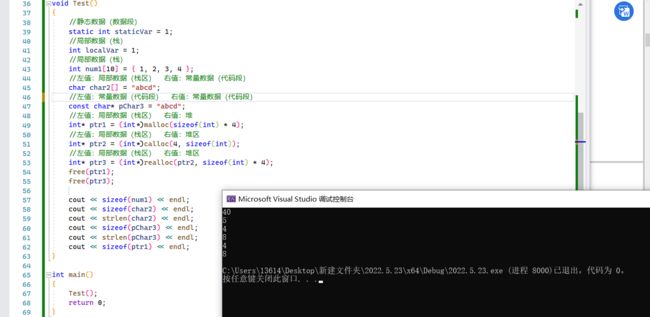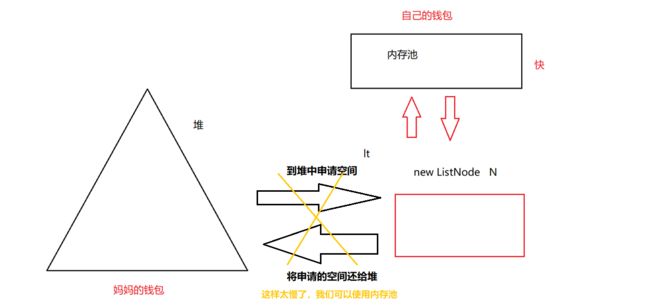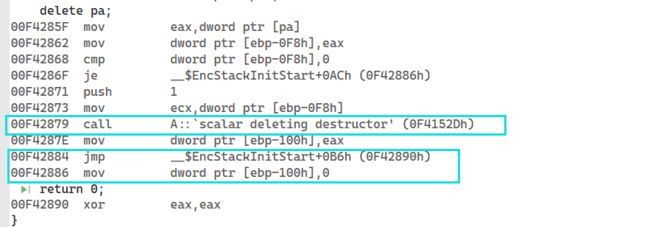C/C++内存管理分析
目录
- 前言
-
- 内存管理
- 1、C/C++内存分布
- 2、C语言中内存管理的方式
- 3、C++内存管理方式
-
- 3.1、new/delete操作内置类型
- 3.2、new和delete操作自定义类型
- 4、operator new与operator delete函数
-
- 4.1、二个全局函数的概念
- 4.2 operator new与operator delete的类专属重载(了解)
- 5、new和delete的实现原理
-
- 5.1、内置类型⭐⭐⭐
- 5.2、内置类型⭐⭐⭐
- 6、定位new表达式(placement-new) (了解)
- 7、常见内存管理问题⭐⭐⭐⭐
-
- 7.1、malloc/free和new/delete的区别
- 7.2、内存泄漏
- 7.3、内存泄漏分类
- 7.4、如何避免内存泄漏
- 7.5、如何检测内存泄漏
前言
通过这篇文章,我们可以清楚的了解到
C/C++是如何进行内存管理的,还有各种缺陷…
内存管理
1、C/C++内存分布
首先我们指定的进程虚拟内存分为:
- 栈:栈又叫堆栈,存储非静态局部变量/函数参数/返回值等等,栈是向下增长的
- 内存映射段:内存映射段是高效的I/O映射方式,用于装载一个共享的动态内存库。用户可使用系统接口创建共享内存,做进程间通信(现在只需要了解一下)
- 堆:堆用于程序运行时 动态内存分配,堆是可以上增长的
- 数据段:数据段–存储全局数据和静态数据
- 代码段: 代码段–可执行的代码/只读常量
我们先看下面一段代码和问题:
int globalVar = 1;
static int staticGlobalVar = 1;
void Test()
{
static int staticVar = 1;
int localVar = 1;
int num1[10] = { 1, 2, 3, 4 };
char char2[] = "abcd";
char* pChar3 = "abcd";
int* ptr1 = (int*)malloc(sizeof(int) * 4);
int* ptr2 = (int*)calloc(4, sizeof(int));
int* ptr3 = (int*)realloc(ptr2, sizeof(int) * 4);
free(ptr1);
free(ptr3);
}
这段代码中的数据是存储在哪里的呢?
//全局数据(数据段)
int globalVar = 1;
//静态数据(数据段)
static int staticGlobalVar = 1;
//函数(栈区)
void Test()
{
//静态数据(数据段)
static int staticVar = 1;
//局部数据(栈)
int localVar = 1;
//局部数据(栈)
int num1[10] = { 1, 2, 3, 4 };
//左值:局部数据(栈区) 右值:常量(只读)数据(代码段) *char2:局部数据(栈区)
char char2[] = "abcd";
//左值:局部数据(栈区) 右值:常量(只读)数据(代码段)
const char* pChar3 = "abcd";
//左值:局部数据(栈区) 右值:堆区
int* ptr1 = (int*)malloc(sizeof(int) * 4);
//左值:局部数据(栈区) 右值:堆区
int* ptr2 = (int*)calloc(4, sizeof(int));
//左值:局部数据(栈区) 右值:堆区
int* ptr3 = (int*)realloc(ptr2, sizeof(int) * 4);
//库函数(栈区)
free(ptr1);
free(ptr3);
}
这段代码中开辟连续空间数据的内存和字符数组的长度为多少呢?
#include 注意:指针在32位系统下是4个字节,在64位地址下是8个字节

2、C语言中内存管理的方式
C语言中主要由malloc、calloc、realloc和free来进行内存管理:
以上库函数都在#include
头文件中所定义
- void* malloc(size_t size):分配 size 字节的未初始化内存,若分配成功,则返回指向分配内存块最低位(首位)字节的指针
void Test()
{
// 在堆区分配十个整形的空间
int* p = (int*)malloc(sizeof(int) * 10);
free(p);
}
- void* calloc(size_t num, size_t size):为num个对象的数组分配内存,并初始化所有分配存储中的字节为零,若分配成功,会返回指向分配内存块最低位(首位)字节的指针
void Test()
{
// 在堆区分配十个整形空间,并且全部默认初始化为0
int* p = (int*)calloc(10, sizeof(int));
free(p);
}
- void* realloc(void* ptr, size_t new_size):重新分配给定的内存区域,必须是之前为malloc 、calloc或realloc所分配,并且仍未被 free 或 realloc 的调用所释放。否则,结果未定义
void Test()
{
// 在堆区分配十个整形空间
int* p = (int*)malloc(sizeof(int) * 10);
// 重新分配p所指向的空间的大小
int* pp = (int*)realloc(p, sizeof(int) * 10000);
// 如果pp重新分配成功,则会自动释放p所分配的空间
if(pp)
free(pp);
else
free(p);
}
注意:
- 如果重新分配成功,则原来的旧空间会自动被释放
- 若无足够的空间进行重新分配,则旧空间不会被释放,会返回一个NULL
- 若旧空间指针为NULL,则与调用malloc的机制函数一样
- void free( void* ptr ):释放由malloc、calloc和realloc所分配的空间,释放后,指针会变成野指针,指向一个随机的地址
void Test()
{
int* p = (int*)malloc(sizeof(int) * 10);
// 释放p所指向的动态空间
free(p);
}
malloc、calloc和realloc之间的区别是什么呢?⭐⭐⭐
- malloc与其他函数的区别是:它可以分配空间但不能进行初始化
- calloc与malloc的区别是:它可以分配空间并且默认初始化为0,但malloc不行
- realloc和其他函数的区别是:它可以将开辟好的空间进行重新分配
3、C++内存管理方式
前言:
C语言内存管理方式在C++中是兼容的,但是在有些地方使用起来比较麻烦,所以C++就自己提出了内存的管理方式:通过 new 和 delete 操作符进行内存管理
3.1、new/delete操作内置类型
void Test()
{
// 动态申请一个int类型的空间
int* ptr4 = new int;
// 动态申请一个int类型的空间,并且初始化为10
int* ptr5 = new int(10);
// 动态申请3个int类型的空间
int* ptr6 = new int[3];
// 释放ptr4、ptr5所分配的空间
delete ptr4;
delete ptr5;
// 释放ptr6所分配的连续空间
delete[] ptr6;
}
int main()
{
Test();
return 0;
}
注意:申请和释放单个元素的空间,使用new和delete操作符,申请和释放连续的空间,使用new[]和delete[]

总结:
- C语言中的内存管理在对内置内置进行开辟空间时不能指定初始化的值
- C++内存管理代码比C语言中的代码简练,易懂
- C语言中开辟空间还需要对指针进行判空,而new会抛异常
void Test()
{
//开辟1G堆空间,如果开辟失败,new将抛异常
void* p3 = new char[1024 * 1024 * 1024];
}
int main()
{
// 开辟1G堆空间
void* p1 = malloc(1024 * 1024 * 1024);
//开辟1G堆空间,如果开辟失败,malloc返回空指针
void* p2 = malloc(1024 * 1024 * 1024);
cout << p2 << endl;
//如果引发异常时(执行throw语句),没有try块或没有匹配处理时,将默认调用abort()函数
//判断try块中的内容是否会引发异常
try
{
Test();
}
//捕获引发的异常
catch (const exception& e)
{
cout << e.what() << endl;
}
return 0;
}
注意:异常还没有学到,需要继承后才能讲到,这里看看就好!
3.2、new和delete操作自定义类型
class Test
{
public:
Test()
: _data(0)
{
cout << "Test():" << this << endl;
}
~Test()
{
cout << "~Test():" << this << endl;
}
private:
int _data;
};
void Test1()
{
// 申请单个Test类型的空间
Test* p1 = (Test*)malloc(sizeof(Test));
free(p1);
// 申请10个Test类型的空间
Test* p2 = (Test*)malloc(sizeof(Test) * 10);
free(p2);
}
void Test2()
{
// 申请单个Test类型的对象
Test* p1 = new Test;
delete p1;
// 申请10个Test类型的对象
Test* p2 = new Test[10];
delete[] p2;
}
int main()
{
Test1();
Test2();
return 0;
}
注意:在申请自定义类型的空间时,new会调用构造函数,delete会调用析构函数,而malloc与free不会

结论:
- 使用malloc对自定义类型进行内存管理时,不会调用其构造函数进行初始化
- 使用new对自定义类型进行内存管理时,会开辟空间并且调用构造函数生成匿名对象进行初始化
- 使用delete或delete[]时,调用析构进行资源清理,并且释放new开辟的空间
class A
{
public:
A(int size = 0)
: p(new int)
, _size(size)
{
cout << "A(int size = 0)" << endl;
}
~A()
{
cout << "~A()" << endl;
delete p;
}
private:
int* p;
int _size;
};
int main()
{
// 首先:开辟空间,然后调用构造函数进行初始化
A* p = new A;
// 调用析构函数进行资源清理,然后将开辟的空间释放
delete p;
return 0;
}
注意:匿名对象是没有名称的自定义类型,生命周期只有本行,被const引用或对其进行内存管理时,会延长生命周期
4、operator new与operator delete函数
4.1、二个全局函数的概念
- new和delete是用户进行动态内存申请和释放的操作符
- operator new 和operator delete是系统提供的全局函数
- new在底层调用operator new全局函数来申请空间
- delete在底层通过operator delete全局函数来释放空间
operator new源码
/*
operator new:该函数实际通过 malloc 来申请空间,当 malloc 申请空间成功时直接返回;
申请空间失败,尝试执行,空间不足应对措施,如果改应对措施用户设置了,则继续申请,否则抛异常
*/
void* __CRTDECL operator new(size_t size) _THROW1(_STD bad_alloc)
{
// try to allocate size bytes
void* p;
while ((p = malloc(size)) == 0)
if (_callnewh(size) == 0)
{
// report no memory
// 如果申请内存失败了,这里会抛出 bad_alloc 类型异常
static const std::bad_alloc nomem;
_RAISE(nomem);
}
return (p);
}
operator delete源码
/*
operator delete: 该函数最终是通过free来释放空间的
*/
void operator delete(void* pUserData)
{
_CrtMemBlockHeader* pHead;
RTCCALLBACK(_RTC_Free_hook, (pUserData, 0));
if (pUserData == NULL)
return;
_mlock(_HEAP_LOCK); /* block other threads */
__TRY
/* get a pointer to memory block header */
pHead = pHdr(pUserData);
/* verify block type */
_ASSERTE(_BLOCK_TYPE_IS_VALID(pHead->nBlockUse));
_free_dbg(pUserData, pHead->nBlockUse);
__FINALLY
_munlock(_HEAP_LOCK); /* release other threads */
__END_TRY_FINALLY
return;
}
/*
free的实现
*/
#define free(p) _free_dbg(p, _NORMAL_BLOCK)
结论:
- 通过上述两个全局函数的实现知道,operator new 实际也是通过malloc来申请空间
- 如果malloc申请空间成功就直接返回,否则执行用户提供的空间不足应对措施
- 如果用户提供该措施就继续申请,否则就抛异常
- operator delete 最终是通过free来释放空间的
接下来看一段测试代码:
class A
{
public:
A(int size = 0)
: p(nullptr)
, _size(size)
{
cout << "A(int size = 0)" << endl;
}
~A()
{
cout << "~A()" << endl;
delete p;
}
private:
int* p;
int _size;
};
int main()
{
//开辟空间时调用malloc,失败时会抛出异常,不会返回空指针
A* a1 = (A*)operator new(sizeof(A));
//通过调用free来释放空间,遇到空指针直接返回
operator delete(a1);
//call operator new(sizeof(A)) ---- call A::A()
A* a2 = new A;
//call A::~A() ---- call operator delete
delete a2;
return 0;
}
4.2 operator new与operator delete的类专属重载(了解)
为什么会有类专属重载呢?
- 因为当使用new重复开辟一个空间,然后又delete释放时,效率会很慢,new通过调用operator new,然后又通过operator new去调用malloc
- CPU会重复到进程虚拟内存中堆区开辟空间
- CPU离进场虚拟进程内存远,所以效率慢

下面代码演示了,针对链表的节点ListNode通过重载类专属 operator new/ operator delete,实现链表节点使用内存池申请和释放内存,提高效率
struct ListNode
{
ListNode* _next;
ListNode* _prev;
int _data;
void* operator new(size_t n)
{
void* p = nullptr;
p = allocator<ListNode>().allocate(1);
cout << "memory pool allocate" << endl;
return p;
}
void operator delete(void* p)
{
allocator<ListNode>().deallocate((ListNode*)p, 1);
cout << "memory pool deallocate" << endl;
}
};
class List
{
public:
List()
{
_head = new ListNode;
_head->_next = _head;
_head->_prev = _head;
}
~List()
{
ListNode* cur = _head->_next;
while (cur != _head)
{
ListNode* next = cur->_next;
delete cur;
cur = next;
}
delete _head;
_head = nullptr;
}
private:
ListNode* _head;
};
int main()
{
List l;
return 0;
}
注意:在类中定义专属operator new和delete后,对类进行动态开辟会去调专属重载函数
5、new和delete的实现原理
5.1、内置类型⭐⭐⭐
- 如果申请的是内置类型的空间,new和malloc,delete和free基本类似
- new/delete申请和释放的是单个元素的空间
- new[]和delete[]申请的是连续空间,而且new在申请空间失败时会抛异常,malloc会返回NULL
5.2、内置类型⭐⭐⭐
- new的原理
- 调用operator new函数申请空间
- 在申请的空间上执行构造函数,完成对象的构造
class A
{
public:
A(int a = 0) : _a(a) {}
private:
int _a;
};
int main()
{
A* pa = new A;
return 0;
}
- delete的原理
- 在空间上执行析构函数,完成对象中资源的清理工作
- 调用operator delete函数释放对象的空间
class A
{
public:
~A() { cout << "~A()" << endl; }
private:
int _a;
};
int main()
{
A* pa = new A;
delete pa;
return 0;
}
- new T[N]的原理
- 调用operator new[]函数,在operator new[]中实际调用operator new函数完成N个对象空间的申请
- 在申请的空间上执行N次构造函数
class A
{
public:
A(int a = 0) : _a(a)
{
cout << "A(int a = 0)" << endl;
}
~A() { cout << "~A()" << endl; }
private:
int _a;
};
int main()
{
A* pa = new A[5];
delete[] pa;
return 0;
}
- delete[]的原理
- 在释放的对象空间上执行N次析构函数,完成N个对象中资源的清理
- 调用operator delete[]释放空间,实际在operator delete[]中调用operator delete来释放空间
class A
{
public:
A(int a = 0) : _a(a)
{
cout << "A(int a = 0)" << endl;
}
~A() { cout << "~A()" << endl; }
private:
int _a;
};
int main()
{
A* pa = new A[5];
delete[] pa;
return 0;
}
6、定位new表达式(placement-new) (了解)
定位new表达式是在已分配的原始内存空间中调用构造函数初始化一个对象
使用格式:
- new (place_address) type或者new (place_address) type(initializer-list)
- 注意:place_address必须是一个指针,initializer-list是类型的初始化列表
使用场景:
- 定位new表达式在实际中一般是配合内存池使用。因为内存池分配出的内存没有初始化
- 所以如果是自定义类型的对象,需要使用new的定义表达式进行显示调构造函数进行初始化
class Test
{
public:
Test()
: _data(0)
{
cout << "Test():" << this << endl;
}
~Test()
{
cout << "~Test():" << this << endl;
}
private:
int _data;
};
void Test1()
{
// pt现在指向的只不过是与Test对象相同大小的一段空间,还不能算是一个对象,因为构造函数没有执行
Test* pt = (Test*)malloc(sizeof(Test));
new(pt) Test; // 注意:如果Test类的构造函数有参数时,此处需要传参
}
int main()
{
Test1();
return 0;
}
7、常见内存管理问题⭐⭐⭐⭐
7.1、malloc/free和new/delete的区别
malloc/free和new/delete的共同点是:都是从堆上申请空间,并且需要用户手动释放
用法上的不同:
- malloc和free是函数,new和delete是操作符
- malloc申请的空间不会初始化,new可以初始化
- malloc申请空间时,需要手动计算空间大小并传递,new只需在其后跟上空间的类型即可
- malloc的返回值为void*, 在使用时必须强转,new不需要,因为new后跟的是空间的类型
底层上的不同:
- malloc申请空间失败时,返回的是NULL,因此使用时必须判空,new不需要,但是new需要捕获异常
- 申请自定义类型对象时,malloc/free只会开辟空间,不会调用构造函数与析构函数,而new在申请空间后会调用构造函数完成对象的初始化,delete在释放空间前会调用析构函数完成空间中资源的清理
7.2、内存泄漏
什么是内存泄漏
- 内存泄漏指因为疏忽或错误造成程序未能释放已经不再使用的内存的情况
- 内存泄漏并不是指内存在物理上的消失,而是应用程序分配某段内存后,因为设计错误,失去了对该段内存的控制,因而造成了内存的浪费
内存泄漏的危害:
- 长期运行的程序出现内存泄漏,影响很大,如操作系统、后台服务等等,出现内存泄漏会导致响应越来越慢,最终卡死
注意:内存泄漏一般是指程序中的指针找不到开辟空间的地址所导致的
void Func()
{
throw;
}
void MemoryLeaks()
{
// 1.内存申请了忘记释放
int* p1 = (int*)malloc(sizeof(int));
int* p2 = new int;
// 2.异常安全问题
int* p3 = new int[10];
try
{
Func(); // 这里Func函数抛异常导致 delete[] p3未执行,p3没被释放
}
catch (const exception& e)
{
cout << e.what() << endl;
}
delete[] p3;
}
int main()
{
MemoryLeaks();
return 0;
}
7.3、内存泄漏分类
C/C++程序中一般我们关心两种方面的内存泄漏:
堆内存泄漏:
- 堆内存指的是程序执行中依据须要分配通过malloc / calloc / realloc / new等从堆中分配的一块内存
- 用完后必须通过调用相应的 free或者delete 删掉
- 假设程序的设计错误导致这部分内存没有被释放,那么以后这部分空间将无法再被使用,就会产生Heap Leak
系统资源泄漏:
- 指程序使用系统分配的资源,比方套接字、文件描述符、管道等没有使用对应的函数释放掉,导致系统资源的浪费,严重可导致系统效能减少,系统执行不稳定
7.4、如何避免内存泄漏
内存泄漏非常常见,解决方案分为两种:
- 事前预防型。如智能指针等
- 事后查错型。如泄漏检测工具
7.5、如何检测内存泄漏
- 在linux下内存泄漏检测:linux下几款内存泄漏检测工具
- 在windows下使用第三方工具:VLD检测工具说明
- 其他工具:其他工具比较
知识点已经干完了,感谢大家支持!!!








